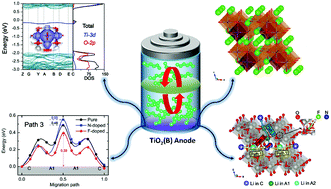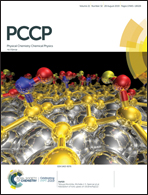First-principles study on screening doped TiO2(B) as an anode material with high conductivity and low lithium transport resistance for lithium-ion batteries†
Abstract
As a promising anode material, TiO2(B) has attracted much attention in recent years due to its high power and capacity performances. First-principles calculations are performed here to reveal the electronic properties and the transport of lithium (Li) in the bulk TiO2(B) with and without atomic doping. It is found that a 4-fold coordinated O atom has the lowest formation energy and the smallest bandgap and is the atom that most easily forms an O-vacancy (Ov). In this work, a series of p-type (N, P, As), n-type (F, Cl, Br), and isoelectronic (S, Se, Te) dopants in TiO2(B) are studied. For n-type dopants, the substitution of the F atom has no significant effect on the electronic structure, which results in the lowest formation energy. This result demonstrates that the F atom can provide high intrinsic stability. Analysis of the insertion process of Li in doped TiO2(B) shows that N-doping is the most competitive choice because it not only introduces a lower bandgap of TiO2(B) but it also has the highest binding energy with Li. The advantage of N-doping is derived from the self-compensation effect. Also, three possible transport paths of Li in TiO2(B) were studied via the CI-NEB method. The results show that the energy barrier of all diffusion paths of F doping is lower than that of pure TiO2(B), where path 2 along the b-axis channel has the lowest energy (0.32 eV). This study is expected to shed some light on the electronic structures of TiO2(B) and the transport properties of Li in it.



 Please wait while we load your content...
Please wait while we load your content...